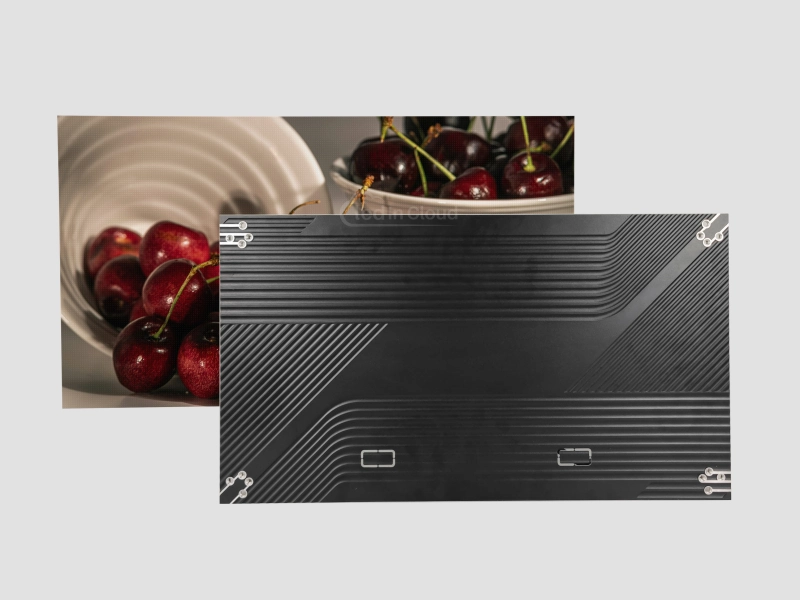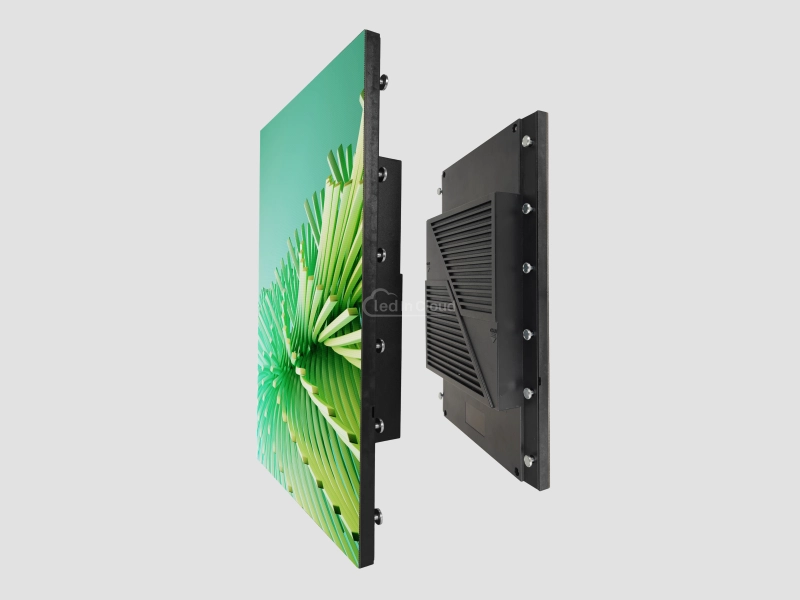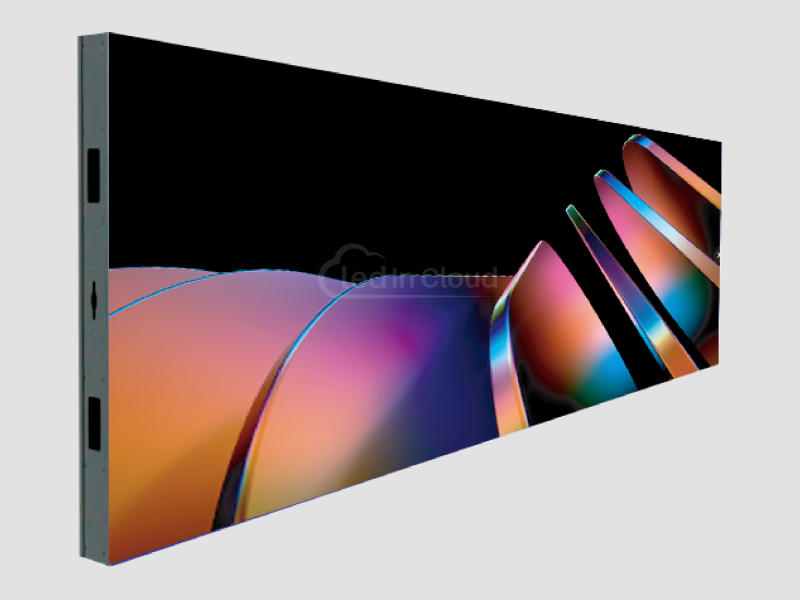
Airport LED Screen
Make your airport smarter, clearer, and more efficient with our custom-built Airport LED Displays. From real-time flight schedules to dynamic wayfinding and revenue-boosting digital ads, our screens are designed to perform 24/7 in demanding airport environments.
✔ Clear and timely flight information for passengers
✔ Durable design for 24/7 high-traffic operation
✔ Sharp visuals even in bright terminals or outdoor zones
✔ Supports dynamic ads and emergency messaging

Airport LED Display Product Recommendations
Upgrade your airport terminals with LED displays designed for performance, clarity, and non-stop operation. Our airport LED screens support real-time FIDS, gate information, wayfinding, and digital ads—all in one system.
With brightness levels up to 6,500 nits, waterproof aluminum cabinets, and ultra-stable signal systems, these displays handle everything from indoor terminals to outdoor drop-off zones. Whether you need small gate signage or large flight info walls, we have a proven solution.
Built for reliability, tested in busy hubs, and optimized for 24/7 use, our LED displays meet the demands of global airports.
- 600×337.5mm Size Cabinet
- 3840Hz High Refresh Rate
- High-End Visual Quality for Indoor Use
- Only 33mm Thickness
- Bright, Saturated Colors
- Multi-Module Split Display Supported
LED Display Price Calculator
Just fill the sizes, and get your LED screen budget right now !
How to Choose the Right LED Screen for Each Area?
Here’s a quick guide based on where it’s installed and what it’s used for.
| 📍 Area | 🖥️ Recommended Type | 🔍 Pixel Pitch | 💡 Brightness | 💬 Notes |
| Terminal Lobby | Indoor LED Wall | P2.5 – P3.0 | 1,000-1,500 nits | Used for large FIDS boards, visible across long halls |
| Gate Area | Narrow LED Display | P1.8 – P2.5 | 800-1,200 nits | Clear display of flight info, even from a few meters away |
| Baggage Claim | Strip Display | P3 – P4 | IP65 sealed | Mounted above carousels to show belt numbers and arrivals |
| Outdoor Entrance | Waterproof Billboard | P6 – P8 | ≥6,000 nits | Used for airport branding, ads, or weather alerts |
| Check-in Counter | Compact LED Sign | P2.5 | Auto dimming | Placed above desks to show airline, queue, or counter info |
| Parking/Drop-Off | Outdoor Roadside Screen | P8 – P10 | High brightness + waterproof | For traffic instructions or parking info |
Step-by-Step Collaboration Process
We make airport LED projects easier to plan, buy, and install. Here’s how we work with you.
① Tell Us Your Project Plan
Send your floor plan or describe your terminal layout. Let us know where you want the screens and what for—FIDS, ads, wayfinding, etc.
② We’ll Recommend a Setup
We suggest screen sizes, pixel pitches, viewing distances, and brightness levels—all based on your budget and airport zone conditions.
③ Production & Testing
Once approved, we begin production. Every screen is tested for 72+ hours non-stop to ensure stability before shipping.
④ Delivery & Support
We pack your LED panels with protective cases and provide installation guides, wiring diagrams, and remote setup support.
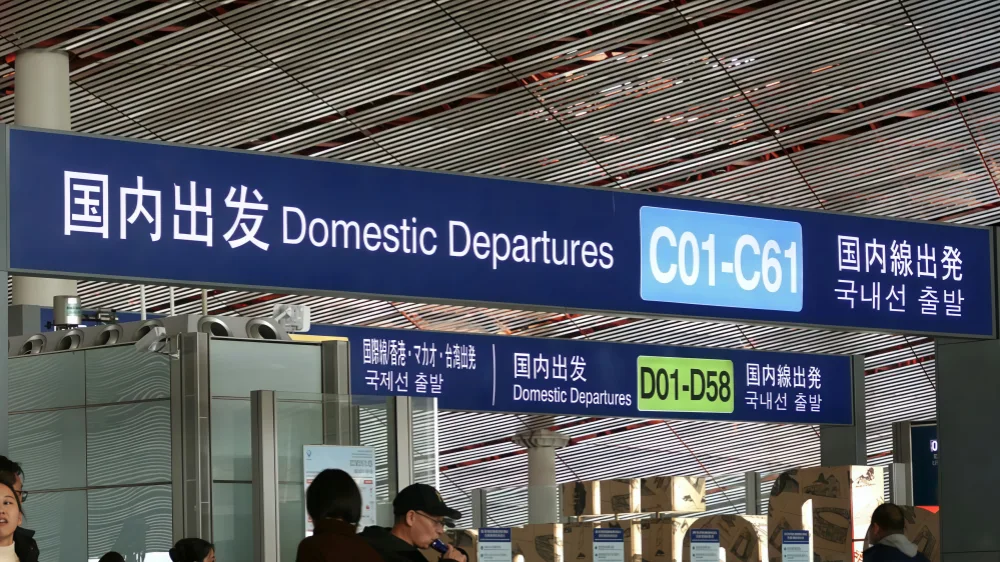
Designed for Different Buyers
Whether you’re a…

Terminal manager
planning a new hall layout
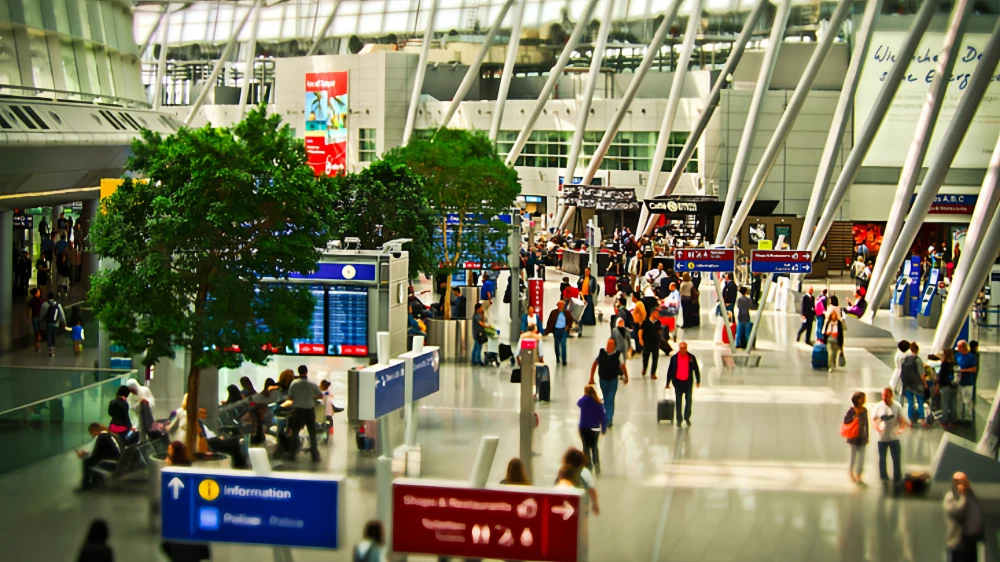
Engineering contractor
sourcing LED hardware
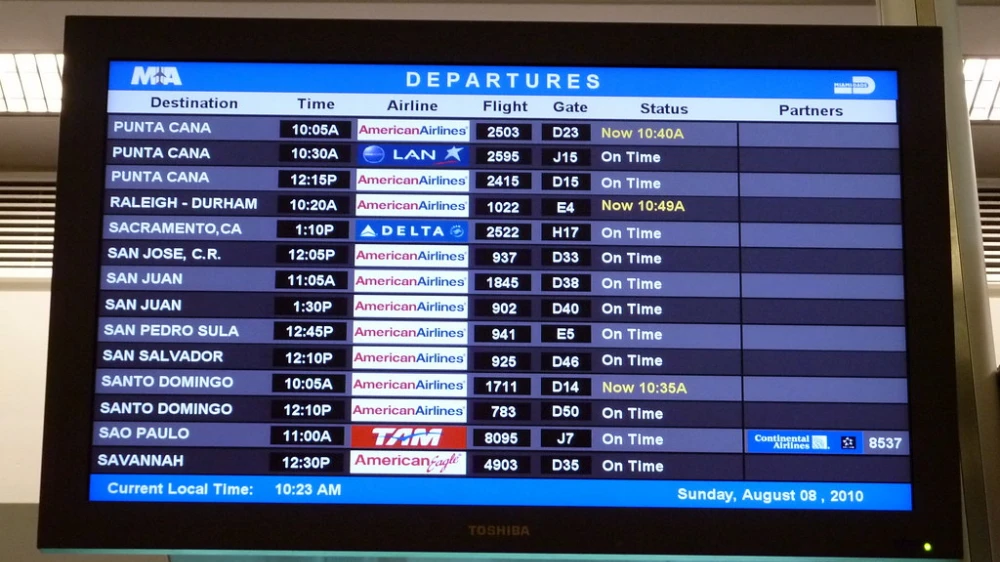
Airport design consultant
comparing suppliers
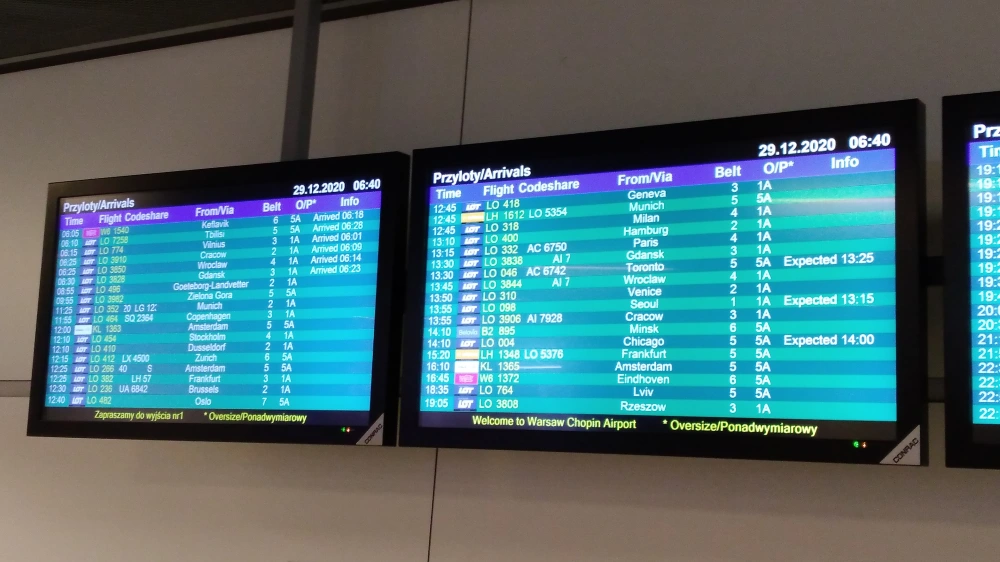
Procurement officer
handling multi-vendor bids
We’ll match the way you work—whether you need CAD layout files, pixel density simulations, or detailed parameter sheets.
Avoiding Common Pitfalls When Buying Airport LED Screens
Not all LED screens are built for airport environments. Here’s what we’ve seen go wrong—and how you can avoid it.
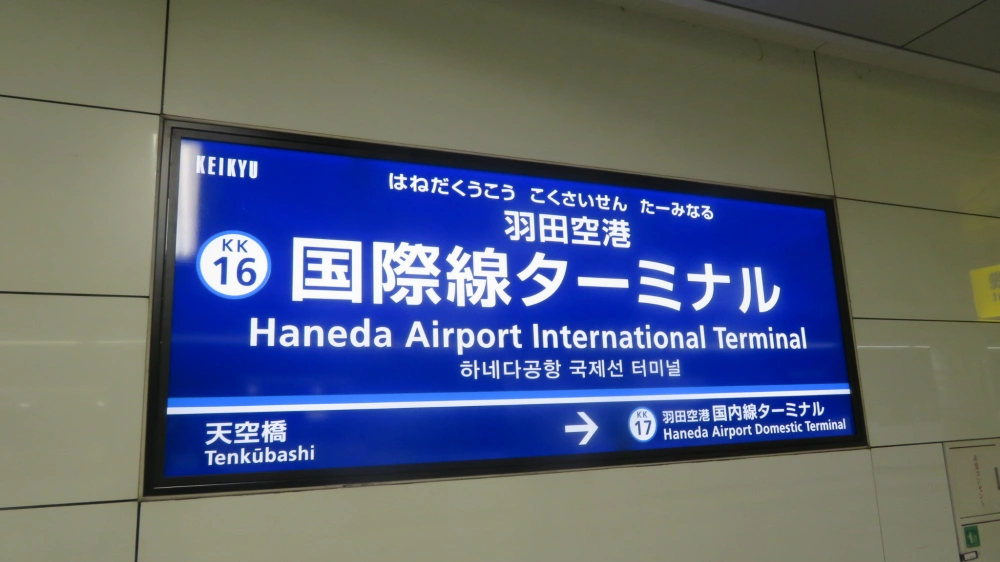
Mistake 1: Using Indoor Screens Outdoors
Problem: Sunlight glare, water damage, overheating.
Fix: Choose IP65-rated panels with ≥6,000 nits brightness.
Mistake 2: Overpaying for Unused Resolution
Problem: Buying P1.5 pitch for 15-meter viewing distance.
Fix: P2.5 or P3.0 is usually enough in large spaces. Save budget for backup power or better frames.
Mistake 3: Ignoring Mounting Conditions
Problem: Using wall brackets near jetways—vibrations loosen bolts or damage edges.
Fix: Use anti-shock steel structures, not glass or plastic shells.
Mistake 4: No Redundancy for Power/Data
Problem: One cable breaks, whole screen goes dark.
Fix: Ask for dual-power and dual-signal backup—especially for FIDS zones.
Send Us Message
If you have any LED display projects or technical problems regarding our LED display products. Please send us a message, we will reply to you in 24 hours.
ATTENTION: lf you bought LED Display & LED Module from other suppliers, Please get help from them directly.
Airport LED Displays: Clear Information, Better Flow, Smarter Airports
Airport LED displays are everywhere – above check – in counters, by the gates, outside terminals. They show flight times, guide passengers, and deliver announcements in real time. Compared to old LCDs or printed signs, LED screens are brighter, faster, and built for heavy use.
In this article, we break down why airports are switching to LED, what kinds of screens they use, and what really matters when choosing one.

1. Airport LED Display Introduction
An airport LED display is more than just a screen on the wall. It’s a key part of how an airport works every day. These displays show real – time flight schedules, gate information, baggage claim updates, and other messages that keep passengers moving and informed.
You’ll find LED screens in almost every part of a terminal: large departure boards, arrival screens, gate signage, digital check – in displays, and even outdoor LED screen for traffic and drop – off instructions.
As airports get bigger and busier, clear and reliable visual communication becomes more important. LED makes that possible – day and night, indoors or outdoors.
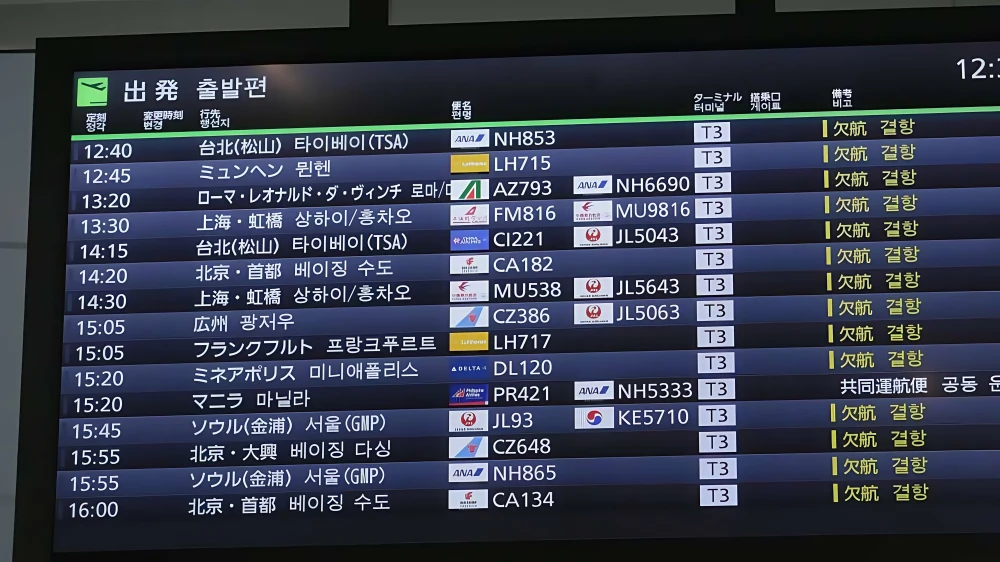
2. Why Airports Rely on LED Displays?
Airports need to share lots of information quickly and clearly. Travelers depend on updates about flights, gates, and baggage.
2.1 The Ugly Truth Before LEDs
❎ Missed flights from confusing gate changes
❎ “Where’s my bag?” panic at carousels
❎ Bored passengers = zero shopping
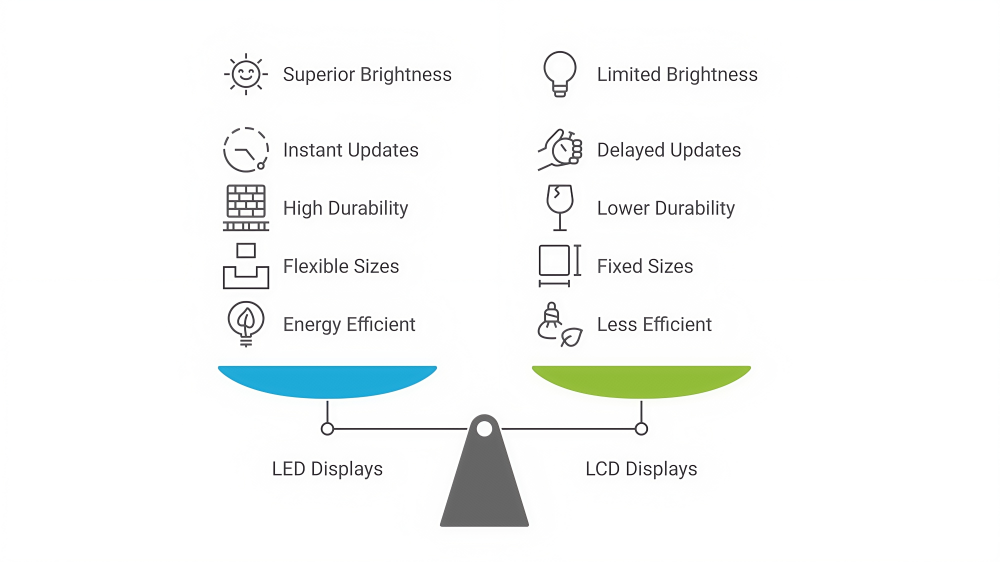
2.2 LEDs Fixed This Mess
✅ Passenger Sanity Saver
Glance → See gate → Walk away. No staff needed.
✅ Money Printer
Duty – free sales jump 19% when ads target long – haul flyers.
✅ Safety Net
When storms hit Dallas Airport, evacuation routes flashed on every screen in <5 seconds.
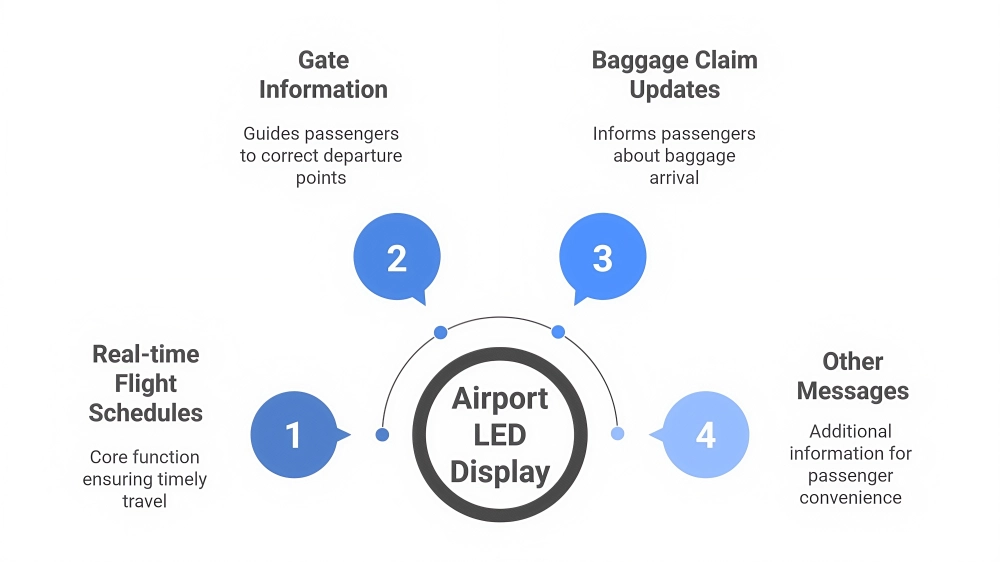
2.3 Why LED Displays Have Become the Go - to Choice
Brightness that Cuts Through Any Light
Airports have big windows and outdoor areas with strong sunlight. LED screens are bright enough to stay readable even in direct sun. That’s something LCDs often struggle with.
Instant Updates, Zero Delays
Flight info changes constantly. Gate assignments shift. Delays happen. LED displays connect directly to airport systems and update instantly. Passengers see the latest info right away.
Durable and Long - Lasting
Airports run nonstop. LED displays are built to handle 24/7 use without flickering or breaking down. They resist dust, moisture, and temperature changes better than many other screens.
Flexible Sizes and Shapes
From giant departure boards to small gate signs, LEDs come in many sizes. Airports can customize displays to fit each spot perfectly.
Energy Efficiency Saves Costs
LEDs use less power than older display types. That adds up when hundreds of screens run day and night.
3. Types of Airport LED Screen
Different areas in an airport require different LED display solutions—each tailored to viewing distance, installation location, and what kind of content it’s meant to show. Here’s a breakdown of the most common types, and the role each plays in airport operations:
3.1 Flight Information Display Screens (FIDS)
These are the large LED boards you see in departure halls and arrival areas. Their job is simple but critical: show real – time flight data like departure times, gate assignments, delays, and cancellations.
✓ Where used: Above check – in counters, security checks, arrival halls
✓ Pixel pitch: Typically P3 – P4
✓ Content: Constantly updated text, color – coded alerts, multi – language display
✓ Key function: Help passengers stay informed and reduce congestion at info desks
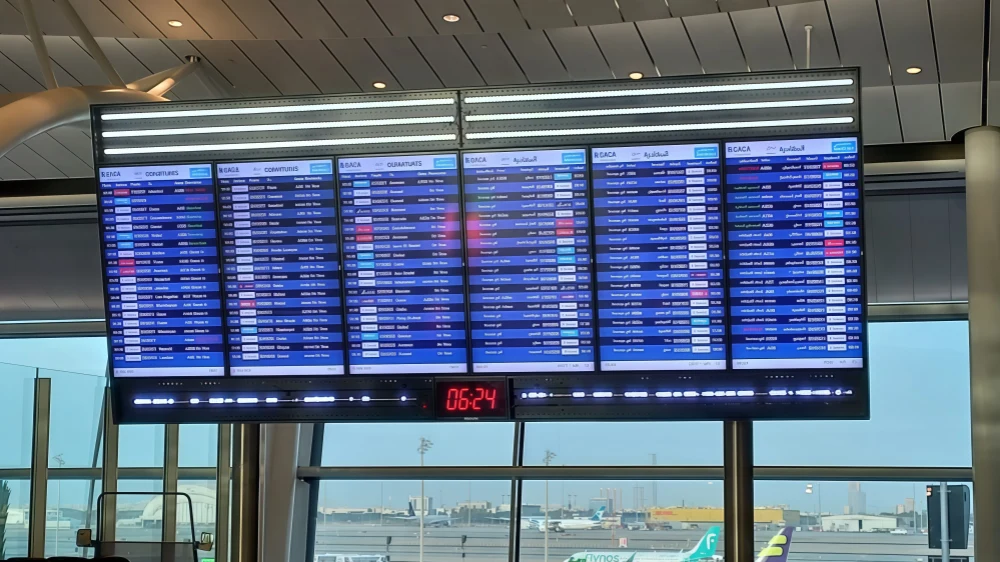
3.2 Gate & Boarding Area Screens
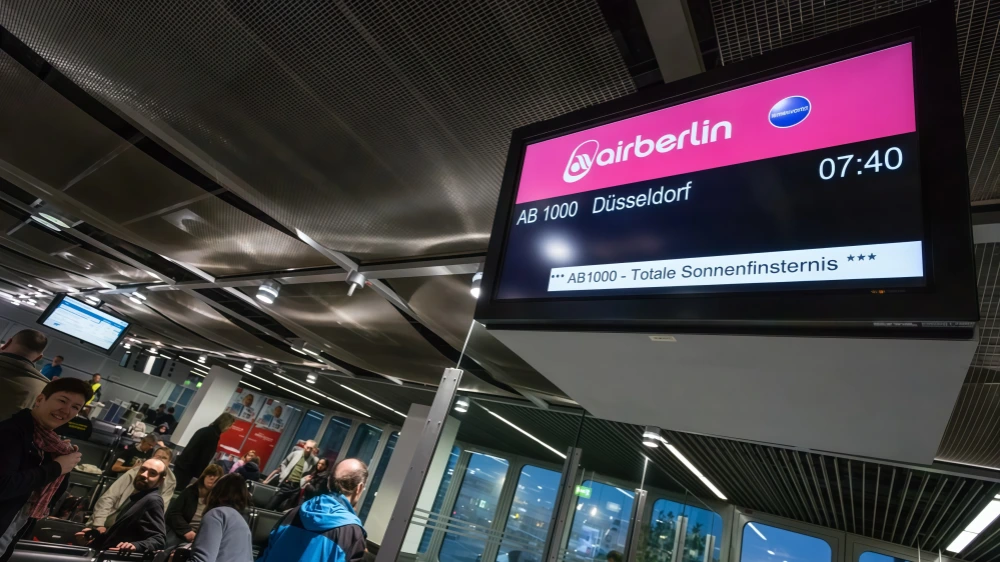
Placed right at the boarding gates, these smaller LED displays show gate – specific details – boarding time, queue updates, final call alerts.
✓ Where used: At each gate counter or waiting area
✓ Pixel pitch: Finer resolution like P1.8 – P2.5 for close – up readability
✓ Content: Countdown timers, boarding group numbers, flashing alerts
✓ Key function: Keep boarding organized and improve on – time performance
3.3 Wayfinding and Directional Signage
Airports are complex environments, and dynamic LED wayfinding displays help passengers navigate them with less stress.
✓ Where used: Main hallways, corridors, terminals
✓ Installation: Wall – mounted, suspended overhead, or as floor – standing kiosks
✓ Content: Arrows, icons, real – time route adjustments for closed zones or security updates
✓ Key function: Improve passenger flow and reduce missed connections
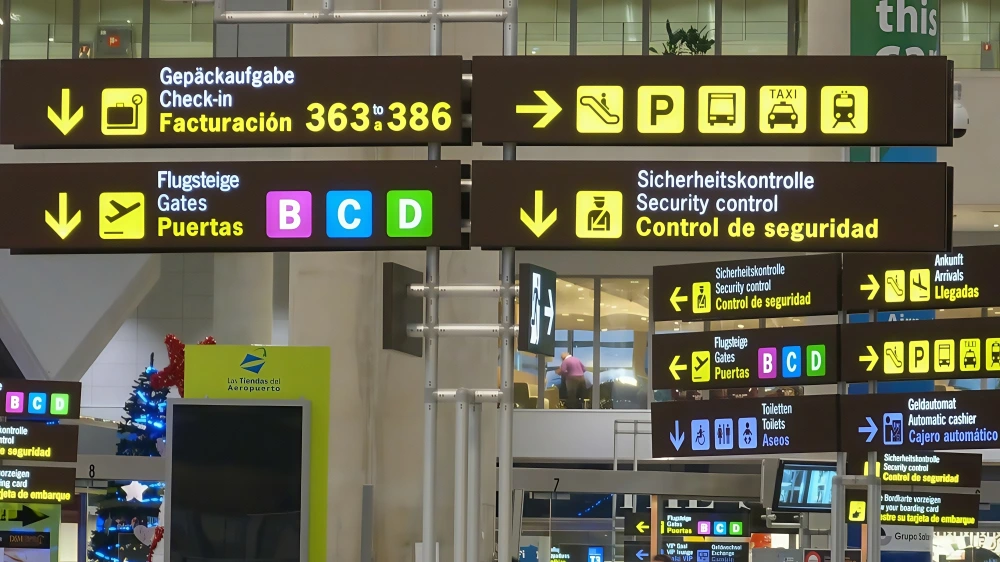
3.4 Advertising LED Displays

These are high – impact LED walls located in busy areas, delivering both commercial advertising and airport branding.
✓ Where used: Duty – free zones, main lobbies, lounges, arrival exits
✓ Pixel pitch: Varies by viewing distance – P2 to P6
✓ Content: Commercial ads, tourism videos, local culture showcases
✓ Key function: Generate advertising revenue and enhance traveler experience
3.5 Check - in Counter Screens
Each check – in desk often features a small LED display to show which airline is operating, which flight is open for check – in, and passenger queue status.
✓ Where used: Above or beside check – in counters
✓ Pixel pitch: Fine pitch (P1.5 – P2.5) for close – range clarity
✓ Content: Airline logos, flight numbers, dynamic queue instructions
✓ Key function: Speed up check – in and reduce confusion
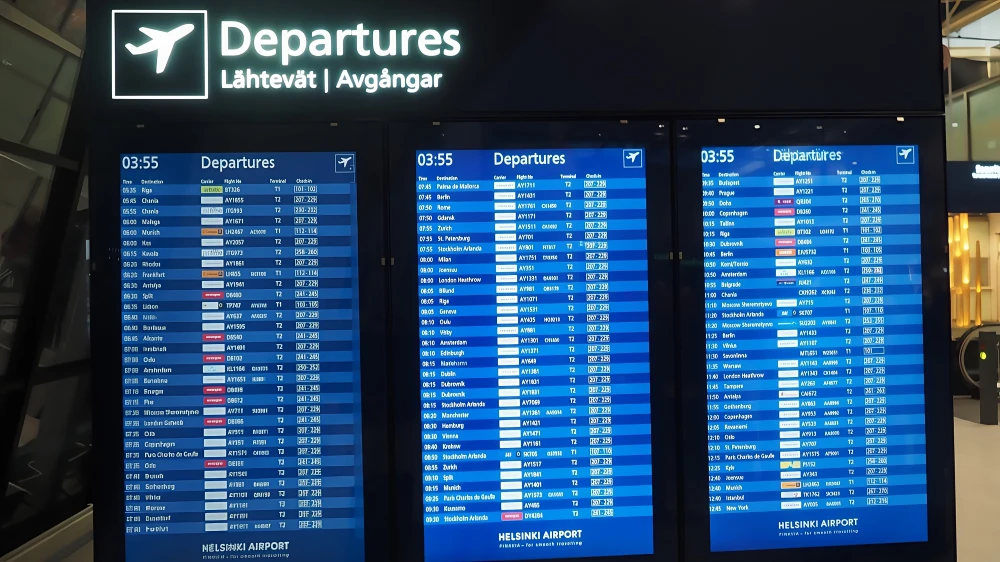
3.6 Baggage Claim Screens
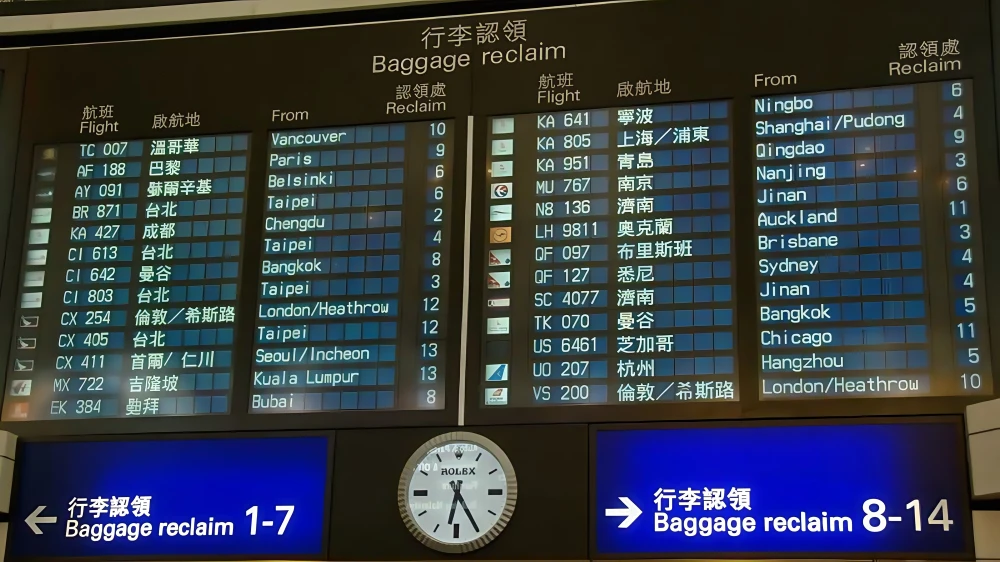
After landing, passengers rely on LED screens above luggage carousels to find their bags. These displays reduce congestion and help avoid missed baggage.
✓ Where used: Baggage claim halls
✓ Content: Flight number, origin city, carousel assignment
✓ Key function: Improve post – flight flow and passenger satisfaction
3.7 Emergency & Alert Displays
In critical situations – such as weather delays or security issues – LED displays switch modes to guide people to safety.
✓ Where used: Throughout terminals
✓ Content: Emergency alerts, evacuation instructions, directional overlays
✓ Key function: Rapid – response communication in emergencies
4. Key Technical Specifications Requirements
Airports have strict requirements when it comes to LED display performance. Each location – whether it’s indoor, outdoor, or a special – use area like baggage claim or control rooms – requires different levels of brightness, resolution, protection, and efficiency.
| Parameter | Description | Indoor Use (Gates, Lounges) | Outdoor Use (Terminals, Parking) | Special Scenarios (Control Rooms, Baggage Areas) |
| Brightness | Screen luminance (cd/m²) | 800 – 1,500 cd/m² | ≥6,000 cd/m² | Transparent screens ≥5,000 cd/m²; adaptive dimming for low light |
| Pixel Pitch | Distance between pixels (mm) | P1.2 – P3 (fine pitch) | P4 – P10 (wide pitch) | Control centers use very fine pitch P0.9 – P1.2 |
| Refresh Rate | Screen refresh speed (Hz) | ≥3,840 Hz | ≥1,920 Hz | High – speed scenes need ≥3,840 Hz |
| Contrast Ratio | Difference between darkest and lightest | ≥5,000:1 | ≥8,000:1 | HDR support to improve image depth |
| Color Uniformity | Brightness and color consistency | ≥95% uniformity | ≥90% uniformity | Color difference ΔE < 2 for broadcast quality |
| Viewing Angle | Horizontal and vertical angles (degrees) | ≥160° H / ≥140° V | ≥140° H / ≥120° V | Wide angles avoid blind spots |
| Color Temperature | Color tone adjustment range | Auto/manual 3000K – 9500K | Auto adjust for day/night | Security screens may use low blue light modes |
| Ingress Protection (IP Rating) | Dust and water resistance level | IP43 (dust resistant) | IP65 (waterproof and dustproof) | IP67 recommended for humid baggage areas |
| Power Efficiency | Energy saving features | Auto brightness+zoned power | Solar integration+smart power | Low standby power <0.1W |
| Redundancy | Backup for power and signal | Dual power supply and hot backup | Dual system failover | Recommended dual control for critical zones |
| Monitoring | Real – time system health tracking | Temperature, humidity, voltage | Cloud alerts and logs | Integration with airport surveillance |
| Control Mode | Signal type | Synchronous real – time | Synchronous+asynchronous mix | Supports HDMI/DP/fiber/wireless |
| Response Time | Display reaction speed | ≤5 ms | ≤5 ms | Low latency for video playback |
| Mounting Options | Installation types | Built – in, ceiling, wall mount | Single/double pole, wall mount | Custom anti – vibration and wind resistance |
5. Global Examples of Airport LED Screen Projects
Airports worldwide are upgrading their display systems with advanced LED screens. These projects show how different airports use LED technology to improve passenger experience, streamline operations, and generate revenue.
5.1 Singapore Changi Airport - Terminal 4
Changi is known for its tech – forward approach. In Terminal 4, they installed over 1,000 fine – pitch LED panels to create a stunning video wall. This display shows real – time flight updates, interactive wayfinding, and even digital art. The LED walls have a pixel pitch of around P2.5, giving sharp images visible from across large spaces.
What’s special here is the integration with their content management system (CMS), which updates flight info instantly and switches content smoothly. It keeps passengers informed while reducing confusion during peak hours.
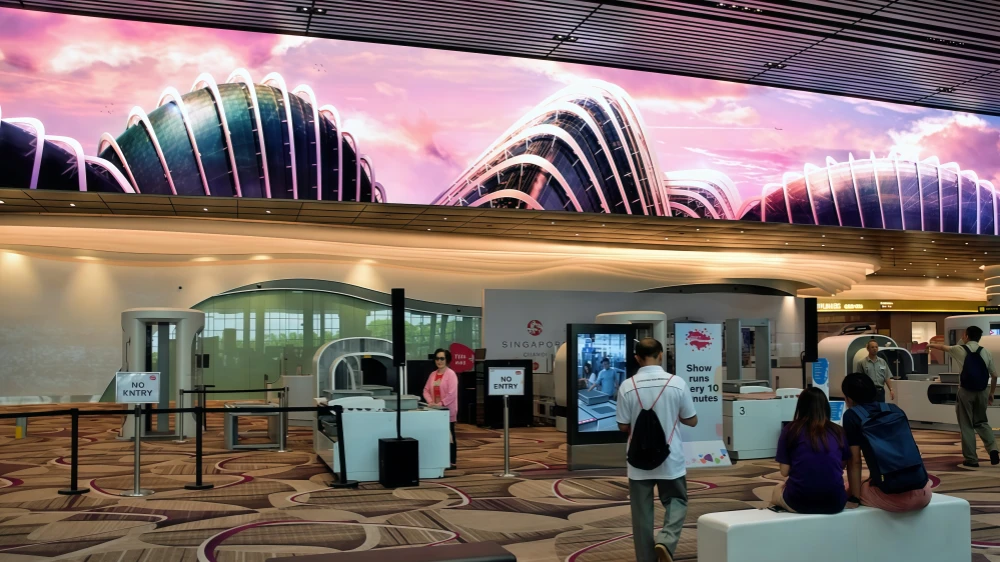
5.2 Los Angeles International Airport (LAX) - West Gates Expansion
LAX installed curved LED video walls at its West Gates, using MicroTiles technology. These high – brightness displays serve dual purposes: they provide flight information and promote local tourism and brands. The screens’ wide viewing angles make them easy to see from various spots.
LAX also uses AI – powered monitoring to predict and reduce downtime. This keeps the displays running 24/7 without disruption, which is critical for busy international hubs.
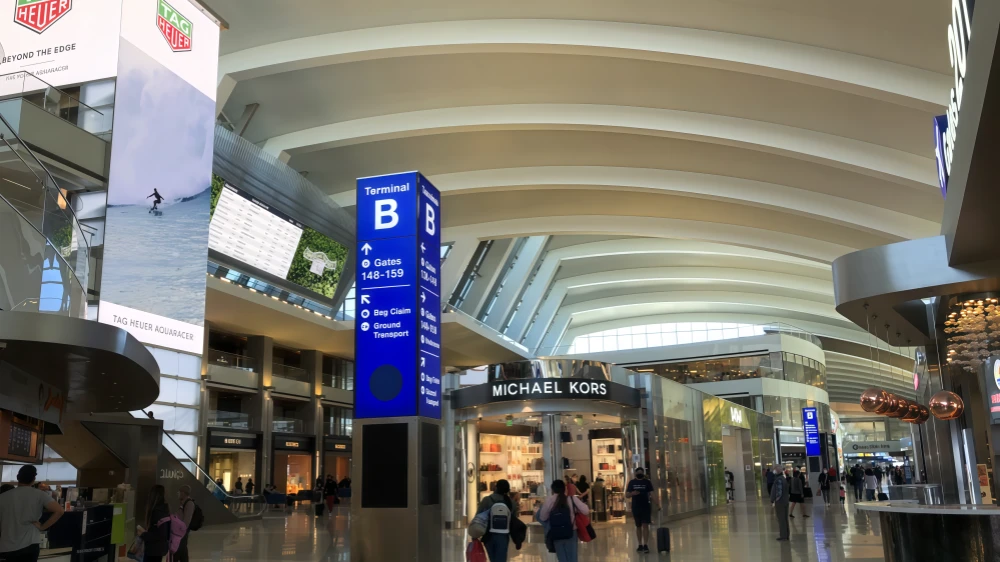
5.3 Helsinki Airport - Digital Art Meets Functionality
Helsinki Airport combines aesthetics and tech with LED installations that double as art. The “digital forest” LED tunnel mimics northern lights with color – changing LEDs, enhancing passenger mood.
Functionally, they use small – pitch LED screens for flight and baggage info with high brightness and contrast, ensuring readability even in bright daylight. Their system supports multilingual content and touch interaction for personalized info.
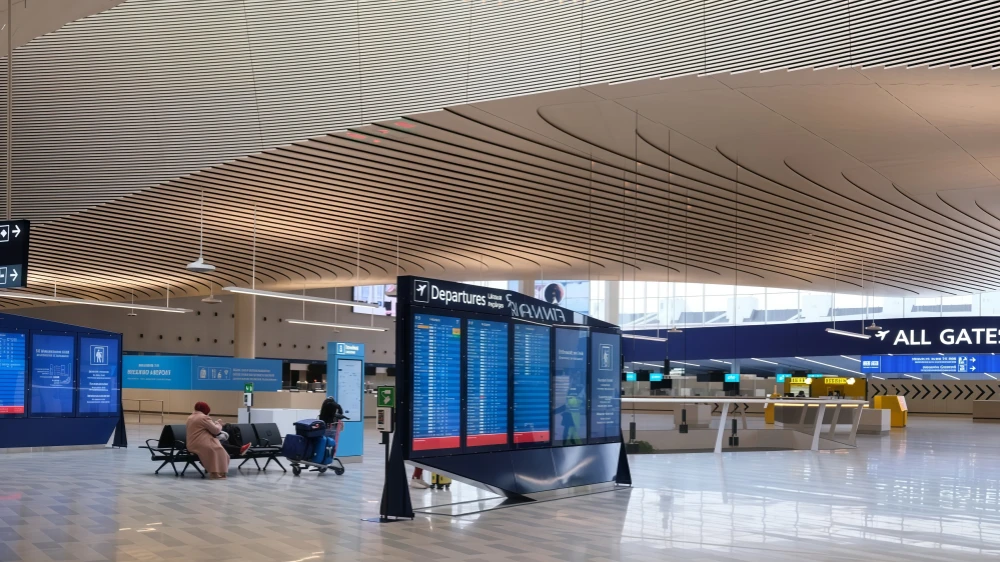
5.4 Hangzhou Xiaoshan International Airport - Terminal 3 LED Network
Hangzhou’s new Terminal 3 is designed as a smart terminal, and LED displays are a core part of its digital strategy. The terminal features a wide range of LED screens, including large – format flight information boards, digital signage at baggage claim, and curved LED walls for wayfinding and advertising.
What stands out is the use of ultra – fine pixel pitch LED screens (as fine as P1.5) in high – traffic areas. These offer excellent clarity even at close viewing distances. All displays are linked to a centralized control system, allowing real – time content updates across the terminal – whether it’s flight changes, emergency messages, or commercial ads.
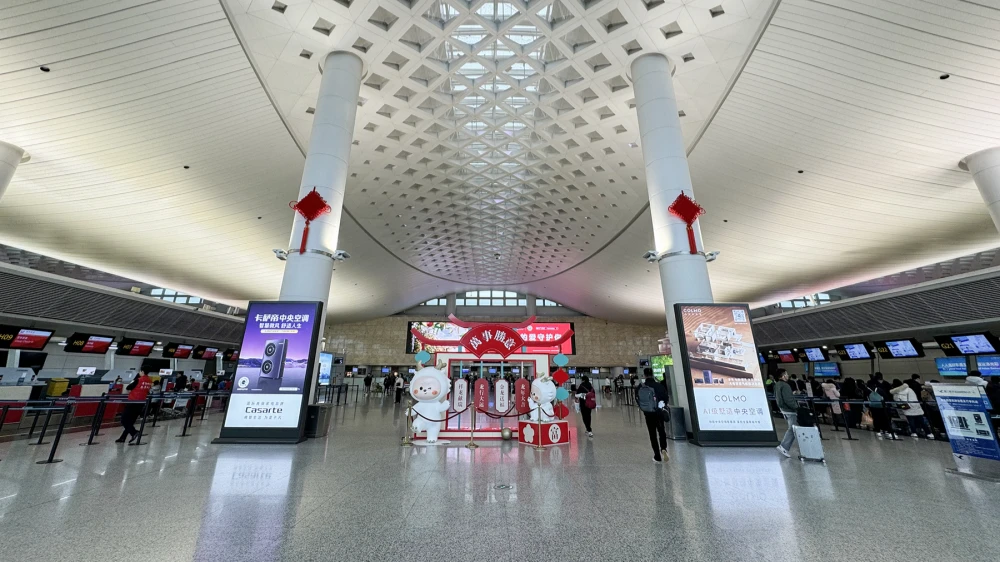
6. What’s Next for Airport LED Displays?
Airport LED screens have already transformed the way terminals communicate, but what’s coming next is even more interesting. The technology is moving beyond basic information display into smarter, more flexible, and more sustainable systems.

(1) Smarter content, driven by real - time data
Future airport LED systems won’t just rotate fixed content – they’ll respond to changing conditions. Displays will auto – switch based on flight schedules, crowd flow, or time of day.
(2) New shapes, new spaces
LED displays are becoming thinner, lighter, and more versatile. Expect to see more curved, wraparound, or transparent screens integrated into columns, glass walls, and even ceilings.
(3) Lower maintenance, longer uptime
With front – access modules, remote diagnostics, and hot – swappable components, the next wave of airport LED screens will be easier to manage. These upgrades reduce downtime and help airport teams keep the system running around the clock.
(4) Greener LED systems
Energy – efficient LED cabinets, automatic brightness control, and scheduling features are helping airports cut power usage. Some are even exploring solar – powered display zones or integrating LED power systems into broader energy management platforms.
(5) From screens to smart environments
We’re moving from isolated LED panels to fully connected display ecosystems. Flight info, advertising, emergency alerts, and interactive signage will all be managed through one digital platform. That shift makes the entire airport more adaptable, responsive, and user – friendly.
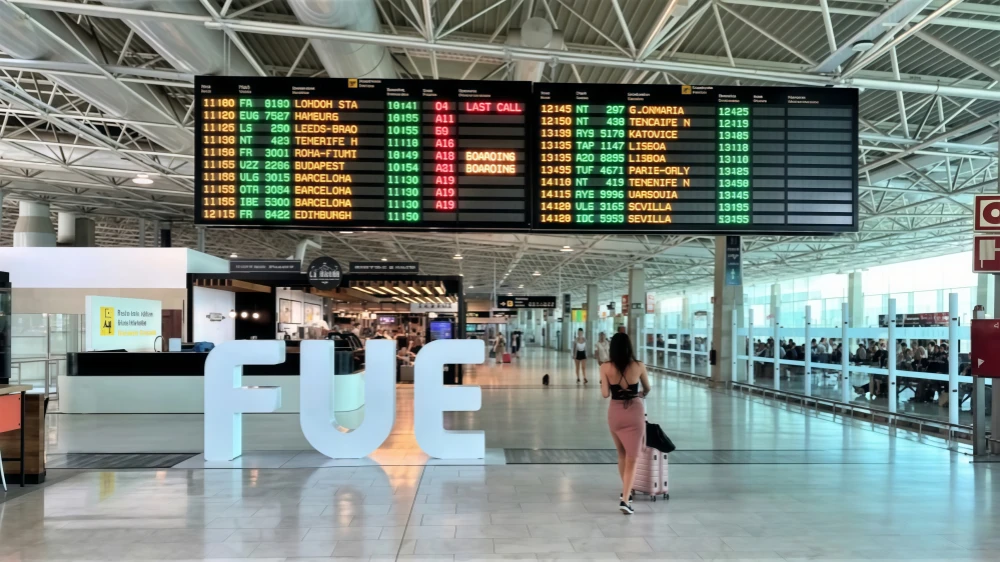
7. Common Questions Buyers Ask
Q: Any supplier you’d actually trust?
A: Must LedInCloud – airport – grade screens, fast shipping, and human support. They offer real testing videos and downloadable specs in LED Screen Cloud Platform, no fluff.
Q: Do I really need 4K?
A: Only if viewers stand <15ft away. Save cash for brightness instead.
Q: What’s the #1 failure point in airport LED screens?
A: Power supply. Ask for dual – redundant PSUs and surge protection.
Q: Can I show both ads and flight info at the same time?
A: Yes. Use split – screen layouts in the CMS – ads on top, info below.
Q: How long to install a 20sqm screen?
A: 3 – 5 days with a pro crew. Add time if site has limited access or power.
Q: What about glare from skylights?
A: Go for >1000 nits brightness and anti – reflective coating.
Q: Should we rent first?
A: For small terminals or events – yes. But buy if 24/7 use is planned.
8. Conclusion
Airport LED displays have moved far beyond simple screens. They keep travelers informed, guide them smoothly through complex terminals, and open new revenue streams for airports.
With fast updates, clear visuals, and flexible content, these displays make airport days less stressful and more efficient. As tech evolves, expect smarter, greener, and more interactive screens to shape the airports of tomorrow.
Purchasing quality LED displays in LedInCloud today sets your airport up for smoother operations and happier passengers tomorrow.
More Solutions
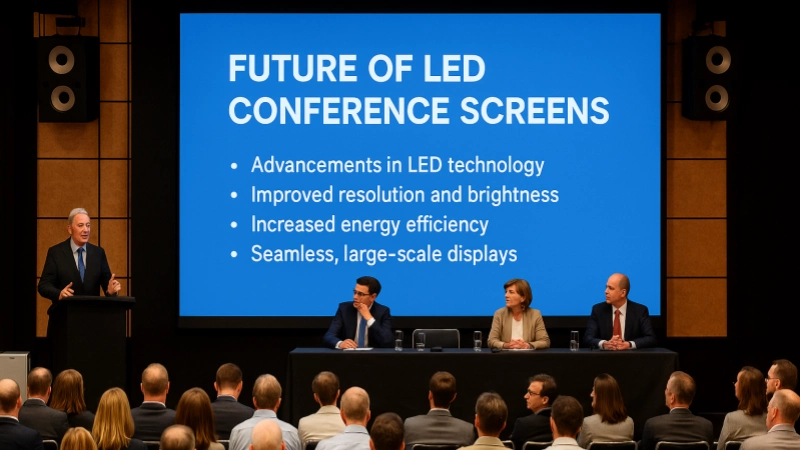
Conference LED Screen
High-resolution display for meetings, events, and presentations with clear visuals and easy setup.

3D LED Screen
Eye-catching naked-eye 3D visuals that attract crowds and boost brand exposure in outdoor spaces.

Stage LED Screen
Dynamic visuals for concerts, events, and live shows, offering vivid effects and seamless synchronization.
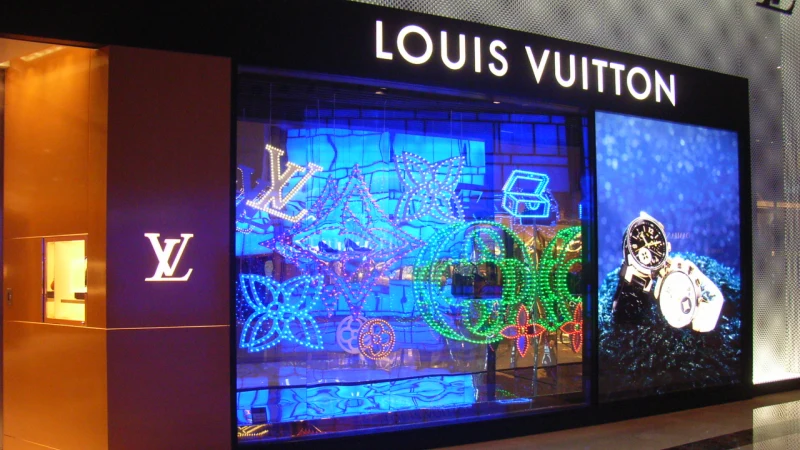
Retail LED Screen
Vibrant digital signage for stores and restaurants to showcase products, menus, and promotions effectively.

